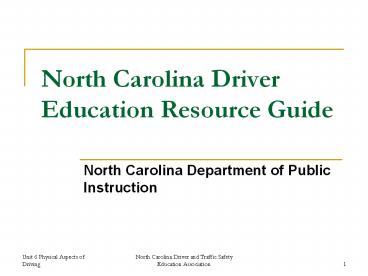North Carolina Driver Education Resource Guide PowerPoint PPT Presentation
1 / 20
Title: North Carolina Driver Education Resource Guide
1
North Carolina Driver Education Resource Guide
- North Carolina Department of Public Instruction
2
Components of the HTS
- People
- Machines
- Environment they operate them in
3
Cause for most motor vehicle crashes
- 90-95 of vehicle accidents are caused by people
not vehicles or roadways. - Human errors are the problem in traffic
accidents.
4
Purpose of driver licensing.
- The purpose of driver licensing is to make sure
that no user of the HTS is an unreasonable risk
to other users of the system or themselves.
5
Importance of vision on driving
- Most information used when using the HTS, is
acquired visually. - Generally, it is accepted that 90 of driving
information is received through the eyes.
6
Things that may affect a person's vision
- Genetics
- Fatigue
- Smoking
- Alcohol or other drugs
7
Things that may affect a person's vision
- Age
- Illness such as allergies or colds
- If 90 of driving information is received
visually, we must have reasonable vision. - NC requires 20/40 corrected vision.
8
Field of vision.
- Field of vision is all the area you need in front
of you. - Normally people can see 180-210 degrees of the
area to the front.
9
Components of field of vision
- Central vision is the area where you see things
clearly. The DMV eye test measures visual acuity,
how clear central vision is. - Fringe Vision is outside central vision where you
can recognize objects but not clearly. - Peripheral vision is the outside of your field of
vision where you see motion but not objects.
10
Things that may affect a person's field of
vision.
- Tunnel vision caused by genetics.
- Other traffic blocking parts of your field of
vision. - Your vehicle's design can block your vision.
- Illness, even temporary illness can cause vision
restrictions. - Age can reduce a person's field of vision as well
as the other effects age can have on vision.
11
Depth perception.
- Depth perception is the ability to judge
distance.
12
Effect color blindness may have on driving
- Although red and green are typically the affected
colors, persons who are colorblind can compensate
for the problem and are no greater risk of
collisions because of their problems.
13
Glare resistance and glare recovery
- Glare resistance is the ability of the pupil to
shut out light (glare). - Glare recovery is the ability of the pupil to
reopen once the bright light is gone and the eye
needs to readjust to low light conditions.
14
Alcohol as a sedative
- Alcohol is a sedative.
- It affects many areas of the body from mental
functions to relaxing muscles and reflexes.
15
Ways alcohol sedates the eyes
- Slowing the pupil, increasing glare and slowing
glare recovery. - Relaxing the muscles that control the lens
reducing visual acuity. - Sedating the retina causing problem of color
recognition especially shades of darkness while
driving. (Seeing pedestrians, bicycles or even
the side of trains at night.)
16
Ways alcohol sedates the eyes
- Binocular vision is the ability of the eyes to
focus together on an object. - Peripheral vision can be narrowed by alcohol.
17
North Carolina and DWI laws
- Laws DWI (Driving While Impaired) only requires
that a person have a blood alcohol concentration
of.08 to be convicted of DWI. - One reason is that no one can see well enough,
even at .08 BAC to drive safely. They are an
unreasonable risk.
18
Disabilities, which may affect a person's fitness
to drive
- Hearing loss. There is usually no increased risk
because of visual compensation by the driver. - Physically challenged persons are not normally a
greater risk. Safe driving is a mental skill so
physical limitations can usually be overcome.
19
Disabilities, which may affect a person's fitness
to drive
- Age. Aging affects all of a person's senses,
including vision, hearing, reactions, and even
mental sharpness. These effects often appear over
years and sometimes not recognized by persons as
they age. - Epileptics are allowed to have a driver's license
(class C) if they are on medication and have gone
seizure free for one year.
20
Disabilities, which may affect a person's fitness
to drive
- Diabetes is a major problem because of the
serious effect of high or low blood sugar. - Mental ability. North Carolina requires at least
a 75 IQ in order to get a driver's license.

